常用方位介词和短语.doc
- 格式:doc
- 大小:63.52 KB
- 文档页数:6
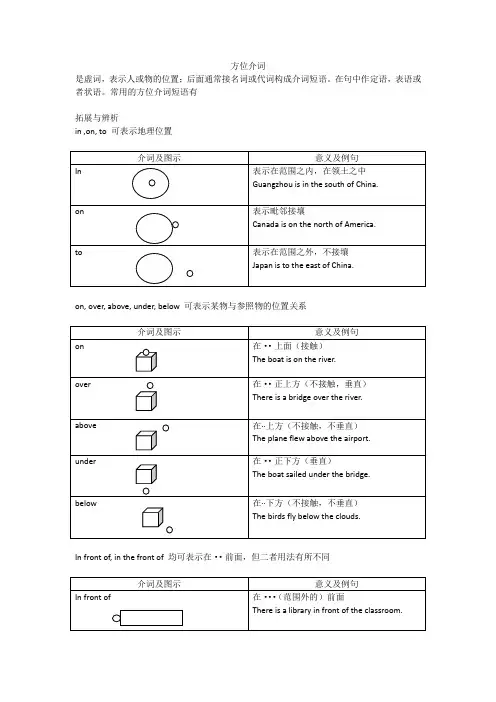
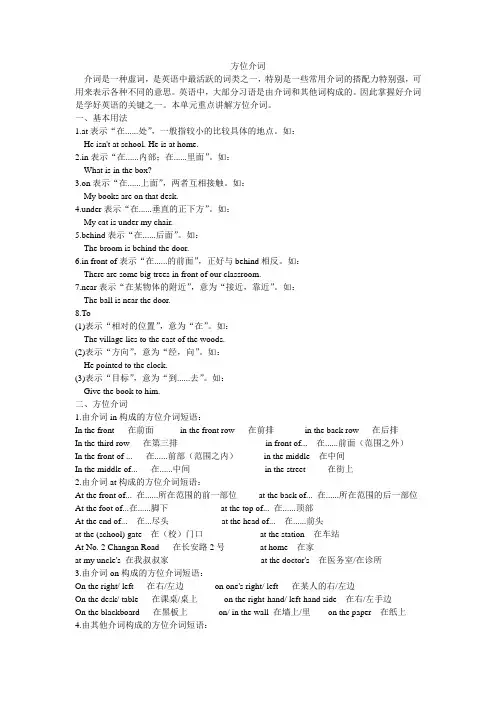
方位介词介词是一种虚词,是英语中最活跃的词类之一,特别是一些常用介词的搭配力特别强,可用来表示各种不同的意思。
英语中,大部分习语是由介词和其他词构成的。
因此掌握好介词是学好英语的关键之一。
本单元重点讲解方位介词。
一、基本用法1.at表示“在......处”,一般指较小的比较具体的地点。
如:He isn't at school. He is at home.2.in表示“在......内部;在......里面”。
如:What is in the box?3.on表示“在......上面”,两者互相接触。
如:My books are on that desk.4.under表示“在......垂直的正下方”。
如:My cat is under my chair.5.behind表示“在......后面”。
如:The broom is behind the door.6.in front of表示“在......的前面”,正好与behind相反。
如:There are some big trees in front of our classroom.7.near表示“在某物体的附近”,意为“接近,靠近”。
如:The ball is near the door.8.To(1)表示“相对的位置”,意为“在”。
如:The village lies to the east of the woods.(2)表示“方向”,意为“经,向”。
如:He pointed to the clock.(3)表示“目标”,意为“到......去”。
如:Give the book to him.二、方位介词1.由介词in构成的方位介词短语:In the front 在前面in the front row 在前排in the back row 在后排In the third row 在第三排in front of... 在......前面(范围之外)In the front of ... 在......前部(范围之内)in the middle 在中间In the middle of... 在......中间in the street 在街上2.由介词at构成的方位介词短语:At the front of... 在......所在范围的前一部位at the back of... 在......所在范围的后一部位At the foot of...在......脚下at the top of... 在......顶部At the end of... 在...尽头at the head of... 在......前头at the (school) gate 在(校)门口at the station 在车站At No. 2 Changan Road 在长安路2号at home 在家at my uncle's 在我叔叔家at the doctor's 在医务室/在诊所3.由介词on构成的方位介词短语:On the right/ left 在右/左边on one's right/ left 在某人的右/左边On the desk/ table 在课桌/桌上on the right-hand/ left-hand side 在右/左手边On the blackboard 在黑板上on/ in the wall 在墙上/里on the paper 在纸上4.由其他介词构成的方位介词短语:Next to 靠近/ 贴近behind the door 在门后near the window 靠近窗户between A and B 在A和B之间beside the desk 在课桌旁under the bed 在床下outside the gate 在门外among the hills 在山里真题例析( )1. Sally is very happy. There is a big smile _____ her face.A.onB.toC.inD.at( )2.--Peter, can you tell me the differences_____ the four words?A.betweenB.amongC.for( )3. People _____ the southwest of China were in great need of water a couple of months ago.A.inB.atC.toD.on( )4. Y ou'd better not always look up the new words_____the dictionary while reading. Sometimes we need to guess.A.inB.onC.atD.from( )5. _____the afternoon of April 30th, many foreign visitors arrived_____ Shanghai.A. In; atB. On; inC. On; to( )6.--Guess, how much does it cost?--I think it costs_____ 15 and 20 dollars.A.fromB.betweenC.amongD.with( )7.--When did your uncle arrive_____ China?--He got to Guangzhou_____ the morning of the 16th of April.A.at; inB.in; inC.to; onD.in;on( )8. The food_____ my country is quite different_____ that here.A.in; likeB.to; fromC.from; toD.in; from( )9. Do you know that Fujian is _____ the west of Taiwan?A.toB.inC.on考点专练一、根据中文提示,用适当的方位介词填空。
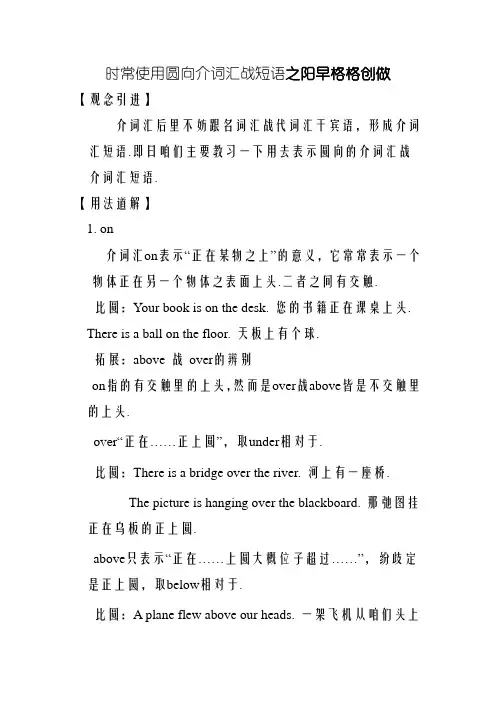
时常使用圆向介词汇战短语之阳早格格创做【观念引进】介词汇后里不妨跟名词汇战代词汇干宾语,形成介词汇短语.即日咱们主要教习一下用去表示圆向的介词汇战介词汇短语.【用法道解】1. on介词汇on表示“正在某物之上”的意义,它常常表示一个物体正在另一个物体之表面上头.二者之间有交触.比圆:Your book is on the desk. 您的书籍正在课桌上头. There is a ball on the floor. 天板上有个球.拓展:above 战over的辨别on指的有交触里的上头,然而是over战above皆是不交触里的上头.over“正在……正上圆”,取under相对于.比圆:There is a bridge over the river. 河上有一座桥.The picture is hanging over the blackboard. 那弛图挂正在乌板的正上圆.above只表示“正在……上圆大概位子超过……”,纷歧定是正上圆,取below相对于.比圆:A plane flew above our heads. 一架飞机从咱们头上The Turners live above us. 特纳一家人住正在咱们的上头.2. in介词汇in表示“正在某物的内里”,它常常表示一个物体正在其余一个物体的内里、中间大概者正在某个范畴之内.比圆:Your pen is in the pencil case. 您的钢笔正在铅笔盒内里.She is the tallest in her class. 她是她们班最下的.3. under介词汇under表示“正在某物的底下”,它常常表示一个物体正在其余一个物体的笔曲正底下,二者之间不交触.比圆:My bike is under the tree. 尔的自止车正在树的底下.The shoes are under the chair. 鞋正在椅子的底下.拓展:under战below 的辨别under表示“正在……之下”,常常表示位子处于正下圆,取介词汇over“正在……上圆”相对于应.比圆: There is a book under the table. 桌子底下有一原书籍. A cat is sitting under the table.一只猫正在桌子底below表示“正在……之下”,“正在……的下游”,取介词汇above相对于应,常指正在某物体之下,然而纷歧定正在该物的正下圆.比圆:He is below the average at school.他的教习结果正在程度以下. I looked down at the hall below.尔瞧了瞧底下的大厅.4. behind介词汇behind表示“正在某物的后里”,它常常表示一个物体正在其余一个物体的后里.比圆:Your brother is behind the tree. 您的弟弟正在树的后里.She is standing behind her mother. 她站正在她妈妈的后里.5. next tonext to是由形容词汇next战介词汇to形成的介词汇短语表示“紧挨着、正在某物的中间”的意义.比圆:The table is next to the wall. 桌子紧挨着墙.6. between介词汇between表示某个物体、某人位于二者之间,常常表示一部分、物处于其余二部分、物之间.比圆:Your desk is between the door and the window. 您的课桌位于门战窗户之间.Lily sits between Mary and Ann. 丽丽坐正在玛丽战安中间.拓展:between战among的辨别between指二者之间, among指三者大概三者以上的人大概物之间.比圆:The teacher is among the students.教授正在教死们中间.7. outsideoutside指“正在……表里”比圆:There are many people outside the room. 房间中有很多人.What did you see outside the hall? 您正在大厅中瞅睹了什么?8.nearnear正在……附近,取far相对于比圆:A hospital was built near the railway station.正在火车站附近修了一所医院.My home is near the school. 尔的家离书籍院很近. 9.in front of, in the front ofin front of正在……前里, in the front of表示“正在……前部”,指内里.比圆:A river flows in front of the house.房子前有一条河.There is a boy in the front of the car. 车的前座坐着一个小男孩.10. aroundaround正在……周围,盘绕比圆:There are many trees around the village.村落周围有很多树盘绕.There are flowers around the stage. 舞台周围晃着陈花.11. at“at”意为“正在……”,不妨用正在天面前也不妨用正在时间前.比圆:Let’s meet at the school gate. 咱们正在书籍院门心睹里吧.I get up at seven o’clock. 尔七面起床.【坚韧训练】Ⅰ. 把下列词汇组翻译成英语.1.正在沙收上_____________2.正在桌子底下____________3.正在您的背包里____________4.正在抽屉里___________5.正在课堂(中部)前里__________Ⅱ. 单项选则.1. Your computer is ______ to the door.A. behindB. onC. inD. next2 The map is ____ the wall ____ our classroom.A. on; onB. of; onC. on; atD. on; of3 Look! The window is _____ the wall and the picture is _____ the wall.A. on; onB. in; inC. in; onD. on; in4 -Where is my ball? I can’t see it. Look! It’s _____ the door.A. onB. inC. atD. behind5. Sally is very happy. There is a big smile ______ her face.A. onB. toC. inD. at6. My father is ill (死病), He is ______.A. in bedB. in the bedC. on bedD. on the bed7. There is a map of China ______ the wall in the classroom.A. inB. onC. underD. at8. There are three windows ______ the wall.A.in B. on C. at D. to9. There are many oranges ______ the tree. A bird ______ thetree is eating an orange.A. in; onB. on; onC. in; inD. on; in10. -What time do you usually go to bed?-I usually go to bed ______ 11:00.A. inB. onC. atD. for11. We can see ______ old bike ______ the tree.A. a; underB. the; atC. an; inD. an; under12. My hats and coats are ______.A. on the bedB. under deskC. in roomD. under the my bed13. He put up a map ______ the back wall because there was ahole ______ it.A. on; on B. at; in C. on; in D. on; at14. Don't read ____ the sun.A. atB. underC. withD. in15. The boat is passing___ the bridge.A. through B. belowC. underD. acrossIII.用适合的介词汇挖空.1. A boy is ____ the tree.2. Can you pick(戴) the apples _____ the tree?3. There is a picture _____ the wall.4. There are two windows _____ the wall.5. I live _____ Shanghai.Ⅳ. 阅读漫笔回问问题.Tom’s roomIt’s small but nice. A computer and some CDs are on the desk. His backpack is on the wall. The ID card is on his bed. The shoes are under the bed. A baseball is on the floor. Sally’s roomIt’s very nice. The new pictures are on the wall. Her desk is near the window. Some flowers are on the desk. Where is her schoolbag? Oh, it’s on the chair. We can’t see a hat o n the bed, but we can see Mimi, her cat.The twins’ roomIt’s big and nice. Two pencil cases are on the desk. Many books are on the bookcase. It’s a big bed near the bookcase. One backpack is on the floor, and the other is on the chair. The jackets are behind the door. A picture of their father and mother is on the wall.1.Tom’s ID card is _______ his bed, and his shoes are_______ the bed.2.Sally’s cat is ________ her bed. Her schoolbag is _______the chair.3.The bookcase is ________ the twins’ room. The b ig bed is_______ the door.4.Two pencil cases are ________ the chair in the twins’ room.5. A picture of the twins’ parents is_______ the wall.。
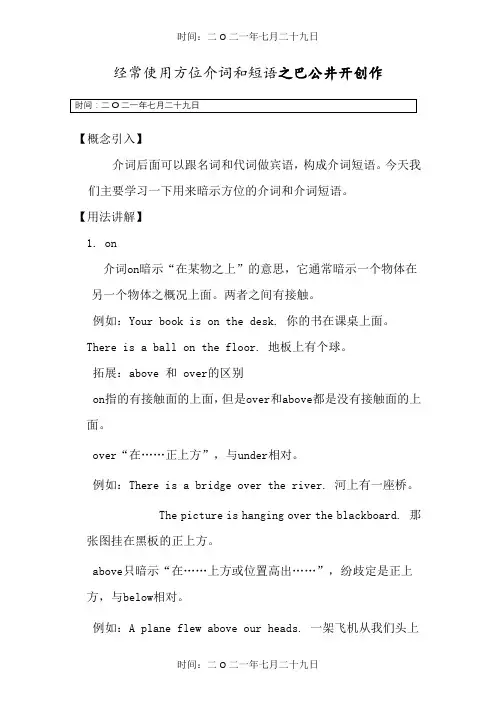
经常使用方位介词和短语之巴公井开创作【概念引入】介词后面可以跟名词和代词做宾语,构成介词短语。
今天我们主要学习一下用来暗示方位的介词和介词短语。
【用法讲解】1. on介词on暗示“在某物之上”的意思,它通常暗示一个物体在另一个物体之概况上面。
两者之间有接触。
例如:Your book is on the desk. 你的书在课桌上面。
There is a ball on the floor. 地板上有个球。
拓展:above 和 over的区别on指的有接触面的上面,但是over和above都是没有接触面的上面。
over“在……正上方”,与under相对。
例如:There is a bridge over the river. 河上有一座桥。
The picture is hanging over the blackboard. 那张图挂在黑板的正上方。
above只暗示“在……上方或位置高出……”,纷歧定是正上方,与below相对。
例如:A plane flew above our heads. 一架飞机从我们头上飞过。
The Turners live above us. 特纳一家人住在我们的上面。
2. in介词in暗示“在某物的里面”,它通常暗示一个物体在另外一个物体的内部、中间或者在某个范围之内。
例如:Your pen is in the pencil case. 你的钢笔在铅笔盒里面。
She is the tallest in her class. 她是她们班最高的。
3. under介词under暗示“在某物的下面”,它通常暗示一个物体在另外一个物体的垂直正下面,两者之间没有接触。
例如:My bike is under the tree. 我的自行车在树的下面。
The shoes are under the chair. 鞋在椅子的下面。
拓展:under和below 的区别under暗示“在……之下”,通常暗示位置处于正下方,与介词over“在……上方”相对应。
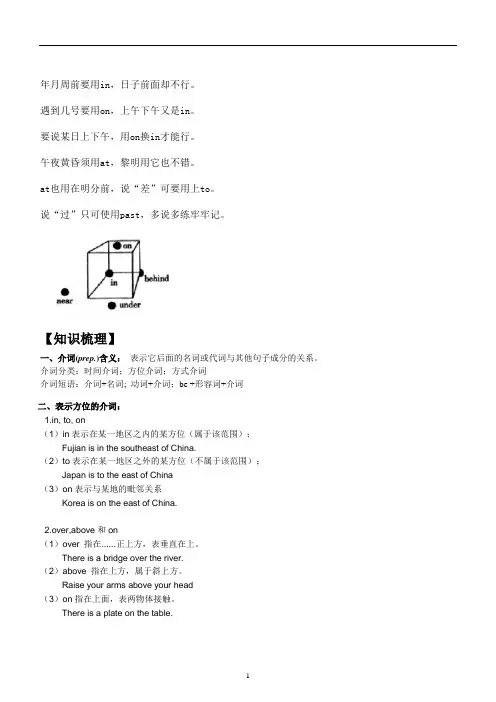
年月周前要用in,日子前面却不行。
遇到几号要用on,上午下午又是in。
要说某日上下午,用on换in才能行。
午夜黄昏须用at,黎明用它也不错。
at也用在明分前,说“差”可要用上to。
说“过”只可使用past,多说多练牢牢记。
【知识梳理】一、介词(prep.)含义:表示它后面的名词或代词与其他句子成分的关系。
介词分类:时间介词;方位介词;方式介词介词短语:介词+名词; 动词+介词;be +形容词+介词二、表示方位的介词:1.in, to, on(1)in表示在某一地区之内的某方位(属于该范围);Fujian is in the southeast of China.(2)to表示在某一地区之外的某方位(不属于该范围);Japan is to the east of China(3)on表示与某地的毗邻关系Korea is on the east of China.2.over,above和on(1)over 指在......正上方,表垂直在上。
There is a bridge over the river.(2)above 指在上方,属于斜上方。
Raise your arms above your head(3)on指在上面,表两物体接触。
There is a plate on the table.3.at,in和on的用法区别(1)at 表示较小的地方。
at the bus stop, at home(2)in 表示较大的地方。
in China, in the world(3)on 表示在一个平面上。
on the table4.(1) in front of在......之前(范围外)。
There are some trees in front of the classroom(2) in the front of表示“在......的前部”(范围内)Our teacher usually sits in the front of the classroom.(3)before所表示的位置关系和in front of 通用,表示“在......前”,“在......面前”5.below,under(1)below表示“在下方或位置低于......”,不一定有垂直在下之意;(2) under表示“在......正下方”。
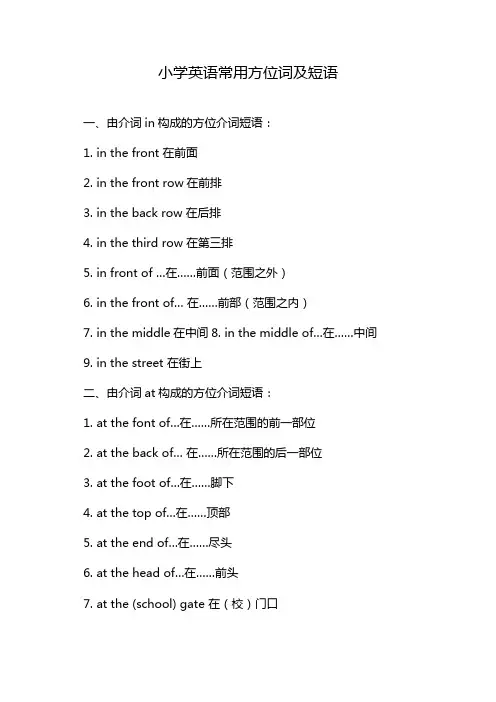
小学英语常用方位词及短语一、由介词in构成的方位介词短语:1. in the front 在前面2. in the front row在前排3. in the back row 在后排4. in the third row 在第三排5. in front of …在……前面(范围之外)6. in the front of…在……前部(范围之内)7. in the middle在中间8. in the middle of…在……中间9. in the street 在街上二、由介词at构成的方位介词短语:1. at the font of…在……所在范围的前一部位2. at the back of…在……所在范围的后一部位3. at the foot of…在……脚下4. at the top of…在……顶部5. at the end of…在……尽头6. at the head of…在……前头7. at the (school) gate 在(校)门口8. at the station 在车站9. at No. 2 Changan Road 在长安路2号10. at my uncle’s在我叔叔家11. at home 在家12. at the doctor’s在医务室/在诊所三、由介词on构成的方位介词短语:1. on the right / left 在右(左)边2. on one’s right / left 在某人的右(左)边3. on the desk / table 在课桌/桌上4. on the right–hand / left–hand side 在右/左手边5. on the blackboard 在黑板上6. on / in the wall 在墙上/里7. on the paper 在纸上四、由其它介词构成的方位介词短语:1. next to 靠近/贴近2. beside the desk 在课桌旁3. behind the door 在门后4. under the bed 在床下5. near the window 靠近窗户6. outside the gate 在门外7. between A and B 在A和B之间8. among the hills 在山中。
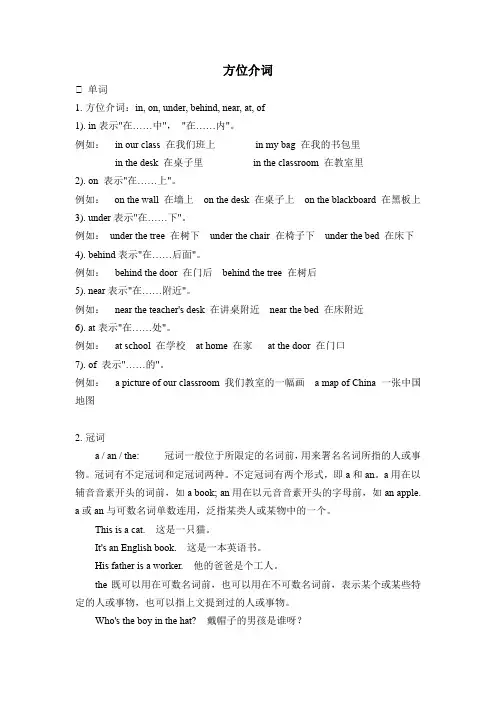
方位介词⑴单词1.方位介词:in, on, under, behind, near, at, of1). in表示"在……中","在……内"。
例如:in our class 在我们班上in my bag 在我的书包里in the desk 在桌子里in the classroom 在教室里2). on 表示"在……上"。
例如:on the wall 在墙上on the desk 在桌子上on the blackboard 在黑板上3). under表示"在……下"。
例如:under the tree 在树下under the chair 在椅子下under the bed 在床下4). behind表示"在……后面"。
例如:behind the door 在门后behind the tree 在树后5). near表示"在……附近"。
例如:near the teacher's desk 在讲桌附近near the bed 在床附近6). at表示"在……处"。
例如:at school 在学校at home 在家at the door 在门口7). of 表示"……的"。
例如: a picture of our classroom 我们教室的一幅画 a map of China 一张中国地图2.冠词a / an / the: 冠词一般位于所限定的名词前,用来署名名词所指的人或事物。
冠词有不定冠词和定冠词两种。
不定冠词有两个形式,即a和an。
a用在以辅音音素开头的词前,如a book; an用在以元音音素开头的字母前,如an apple. a或an与可数名词单数连用,泛指某类人或某物中的一个。
This is a cat. 这是一只猫。
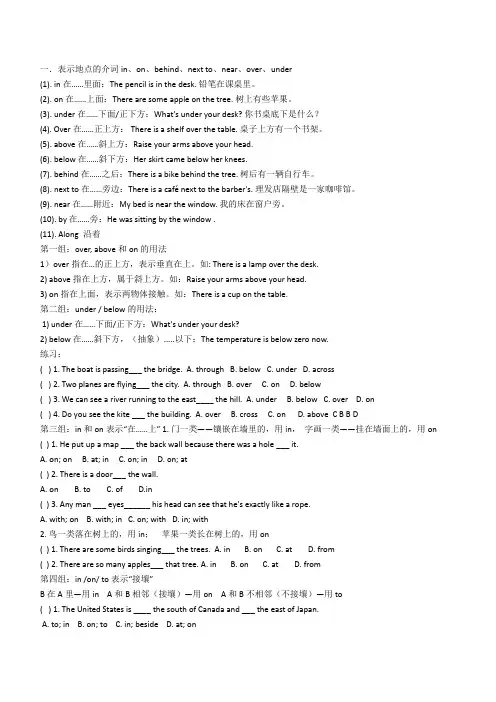
一.表示地点的介词in、on、behind、next to、near、over、under(1). in在……里面:The pencil is in the desk. 铅笔在课桌里。
(2). on在……上面:There are some apple on the tree. 树上有些苹果。
(3). under在……下面/正下方:What's under your desk? 你书桌底下是什么?(4). Over在……正上方: There is a shelf over the table. 桌子上方有一个书架。
(5). above 在……斜上方:Raise your arms above your head.(6). below 在……斜下方:Her skirt came below her knees.(7). behind在……之后:There is a bike behind the tree. 树后有一辆自行车。
(8). next to在……旁边:There is a café next to the barber's. 理发店隔壁是一家咖啡馆。
(9). near在……附近:My bed is near the window. 我的床在窗户旁。
(10). by 在……旁:He was sitting by the window .(11). Along 沿着第一组:over, above和on的用法1)over指在…的正上方,表示垂直在上。
如: There is a lamp over the desk.2) above指在上方,属于斜上方。
如:Raise your arms above your head.3) on指在上面,表示两物体接触。
如:There is a cup on the table.第二组:under / below的用法:1) under在……下面/正下方:What's under your desk?2) below 在……斜下方,(抽象).....以下:The temperature is below zero now.练习:( ) 1. The boat is passing___ the bridge. A. through B. below C. under D. across( ) 2. Two planes are flying___ the city. A. through B. over C. on D. below( ) 3. We can see a river running to the east____ the hill. A. under B. below C. over D. on( ) 4. Do you see the kite ___ the building. A. over B. cross C. on D. above C B B D第三组:in 和on表示“在……上” 1. 门一类——镶嵌在墙里的,用in,字画一类——挂在墙面上的,用on ( ) 1. He put up a map ___ the back wall because there was a hole ___ it.A. on; onB. at; inC. on; inD. on; at( ) 2. There is a door___ the wall.A. onB. toC. ofD.in( ) 3. Any man ___ eyes______ his head can see that he's exactly like a rope.A. with; onB. with; inC. on; withD. in; with2. 鸟一类落在树上的,用in;苹果一类长在树上的,用on( ) 1. There are some birds singing___ the trees. A. in B. on C. at D. from( ) 2. There are so many apples___ that tree. A. in B. on C. at D. from第四组:in /on/ to表示“接壤”B 在A里—用in A和B相邻(接壤)—用on A和B不相邻(不接壤)—用to( ) 1. The United States is ____ the south of Canada and ___ the east of Japan.A. to; inB. on; toC. in; besideD. at; on( ) 2. The man stood____the window, watching the boys playing outside.A. inB. byC. withD. to( ) 3. Japan lies____ the east of China. A. on B. to C. in D. with第五组:at, in表示“在……”at表示较小的地点。
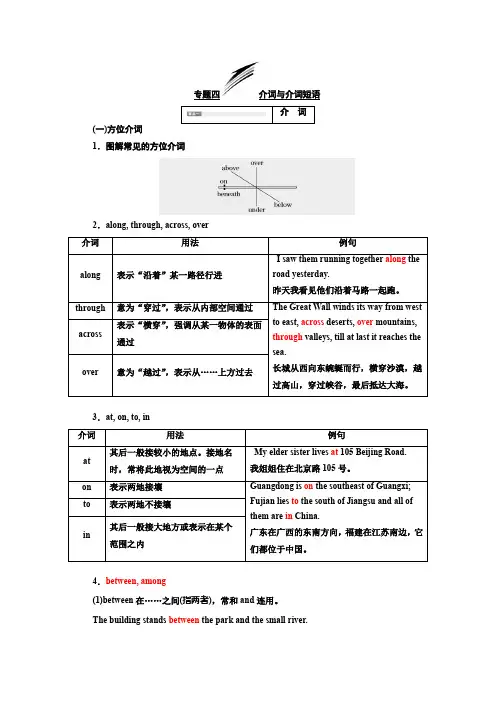
专题四介词与介词短语(一)方位介词1.图解常见的方位介词2.along, through, across, over3.at, on, to, in4.between, among(1)between 在……之间(指两者),常和and 连用。
The building stands between the park and the small river.那栋楼位于公园和小河之间。
(2)among在……之间(指三者或三者以上)。
We'll visit a town among the mountains.我们将要参观一个被群山环绕的小镇。
[名师指津]如果指三个及三个以上的人或物中的每两个之间,仍然要用between。
Switzerland lies between France, Italy, Austria and Germany.瑞士位于法国、意大利、奥地利和德国之间。
(二)时间介词1.in, afterin表时间,常表示“在……之内”,有时in还有“在……之后”的意思,但表示此意时,必须具备两个条件:(1)所在句子的谓语动词必须表将来;(2)后面必须是一段时间。
这两个条件缺一不可,否则用after或later。
My father will be back in three days.我父亲将在三天以后回来。
My father will be back after three o'clock.我父亲将在3点后回来。
My father came back after three days/three days later.我父亲是三天后回来的。
2.for, from, sinceretirement.布朗先生喜欢乡村生活,退休后他在那里生活了差不多15年。
My younger sister began to learn dance from the age of five.我的妹妹从5岁开始学习舞蹈。
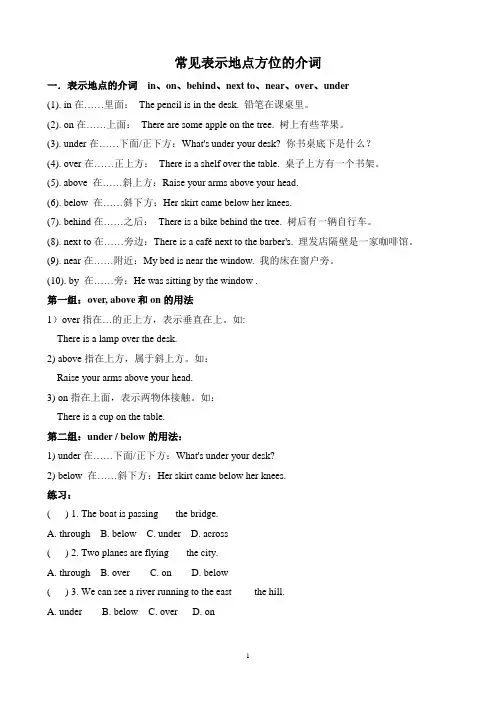
常见表示地点方位的介词一.表示地点的介词in、on、behind、next to、near、over、under(1). in在……里面:The pencil is in the desk. 铅笔在课桌里。
(2). on在……上面:There are some apple on the tree. 树上有些苹果。
(3). under在……下面/正下方:What's under your desk? 你书桌底下是什么?(4). over在……正上方:There is a shelf over the table. 桌子上方有一个书架。
(5). above 在……斜上方:Raise your arms above your head.(6). below 在……斜下方:Her skirt came below her knees.(7). behind在……之后:There is a bike behind the tree. 树后有一辆自行车。
(8). next to在……旁边:There is a café next to the barber's. 理发店隔壁是一家咖啡馆。
(9). near在……附近:My bed is near the window. 我的床在窗户旁。
(10). by 在……旁:He was sitting by the window .第一组:over, above和on的用法1)over指在…的正上方,表示垂直在上。
如:There is a lamp over the desk.2) above指在上方,属于斜上方。
如:Raise your arms above your head.3) on指在上面,表示两物体接触。
如:There is a cup on the table.第二组:under / below的用法:1) under在……下面/正下方:What's under your desk?2) below 在……斜下方:Her skirt came below her knees.练习:( ) 1. The boat is passing___ the bridge.A. throughB. belowC. underD. across( ) 2. Two planes are flying___ the city.A. throughB. overC. onD. below( ) 3. We can see a river running to the east____ the hill.A. underB. belowC. overD. on( ) 4. Do you see the kite ___ the building.A. overB. crossC. onD. aboveC B B D第三组:in 和on表示“在……上”1. 门一类——镶嵌在墙里的,用in,字画一类——挂在墙面上的,用on( ) 1. He put up a map ___ the back wall because there was a hole ___ it.A. on; onB. at; inC. on; inD. on; at( ) 2. There is a door___ the wall.A. onB. toC. ofD.in( ) 3. Any man ___ eyes______ his head can see that he's exactly like a rope.A. with; onB. with; inC. on; withD. in; with2. 鸟一类落在树上的,用in;苹果一类长在树上的,用on( ) 1. There are some birds singing___ the trees.A. inB. onC. atD. from( ) 2. There are so many apples___ that tree.A. inB. onC. atD. from第四组:in /on/ to表示“接壤”B A B A B AB 在A里—用in A和B相邻(接壤)—用on A和B不相邻(不接壤)—用to ( ) 1. The United States is ____ the south of Canada and ___ the east of Japan.A. to; inB. on; toC. in; besideD. at; on( ) 2. The man stood____the window, watching the boys playing outside.A. inB. byC. withD. to( ) 3. Japan lies____ the east of China.A. onB. toC. inD. with第五组:at, in表示“在……”1) at表示较小的地点。
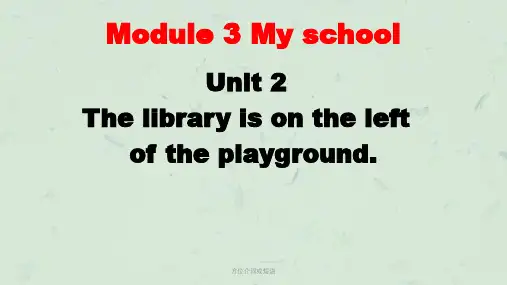
初中英语词汇短语一、方位介词Where is the car?汽车在哪?The car is in front of the garage.汽车在车库前面in front of 在...前面(范围外)in the front of 在...物体内部的前面behind 在...后面in 在...里面on 在...上面above 在...上方below 在...下方over 在...正上方under 在...正下方between 在两者中间among 在...之中(三者以上)next to 紧邻toward 朝;向on top of在...之上near 在...附近about 大约around 在...周围past 经过along 沿着into 到...里面out of 在...之外onto 到...之上off 从...离开up 向上down 向下through (内部)穿过across (表面)穿过二、动词短语break down 出故障(broke 过去式) end up 最终pick up拿;接人;学会;捡起hold up 维持give out 无法继续使用rely on 依赖wear out疲惫不堪put aside 储存keep up with 跟上fall behind 落后catch up on 赶上give up 放弃focus on 集中精力come along 过来fly out 通过飞机离开某地freak out害怕get over 克服run away 逃跑step out 走出去hold back 克制miss out 错过take on 接受;承担go for it 加油open up 敞开split up 分开break off 中断go out 外出get back together 复合let sb.down 让某人失望keep away from 保持距离fall apart 破碎;崩溃turn out 结果是;证明是revolve around 以...为中心stand out 突出;显眼blend into 融入show off 炫耀look down on 鄙视laugh at 嘲笑measure up to 达到标准;符合期望get into 陷入fight over 为...争吵get down on对...表示不满give in屈服;让步put up with 忍受put on 穿上;上演;增加grow apart 渐行渐远bring together 集合;使团结win over 说服;战胜fall for 迷恋ask sb.out 邀请某人出去1bring about 导致start out 开始end up 结束sit around 闲坐wait around 等待stand for 忍耐move on 继续前进;从...中走出stick around 逗留put sb.down 令某人失望go against 违背bring up 教育;培养grow up 长大knock sb.down 使某人倒下lie ahead 在前方boost up鼓励某人rely on 依赖open up 敞开心扉blow away 使惊叹三、日常生活词汇wake up 醒来wash your face 洗脸take a shower 洗个淋浴brush your teeth 刷牙get dressed 穿上衣服brush your hair 刷你的头发do your hair 做你的头发make your bed整理你的床put on makeup 化妆have breakfast吃早餐go to school 去上学drive to work 开车去工作work 工作study 学习wash your hands 洗手have lunch 吃午餐leave school 离开学校get home 到家take a nap 小睡一下have a snack 吃点心do homework 做家庭作业play computer games 玩电脑游戏read a book 阅读一本书play with peers 和同伴玩耍ride a bike 骑单车go shopping 去购物listen to music 听音乐exercise 锻炼mop the floor 拖地vaccum 用真空吸尘器打扫take out the trash 把垃圾带出去water the lawn 给草坪浇水go for a walk 去散步watch TV 看电视do the laundry 洗衣hang the clothes 挂衣服iron the clothes 熨烫衣服do the dishes 洗碗do the dusting做除尘make dinner 做晚饭take a bath 泡澡dry your hair 吹头发go to bed 上床睡觉四、房子词汇房子外部fence 围栏garden花园balcony 阳台chimney 烟囱windows 窗户wall 墙swimming pool 游泳池light 灯door 门attic 阁楼path 小路drainpipe 排水管shutter 百叶窗garage 车库driveway 车道porch 走廊stiars 楼梯basement 地下室roof房顶房子内部attic 阁楼bedroom 卧室living room 客厅laundry room 洗衣房bathroom 浴室study 学习2hallway 走廊dining room饭厅Kitchen 厨房客厅wall 墙floor lamp 落地灯sofa 沙发floor 地板curtains 窗帘window 窗户cushion坐垫table 桌子carpet 地毯armchair 扶手椅picture画chandelier 吊灯air conditioner 空调television 电视television cabinet 电视柜remote control 遥控speaker 扬声器clock 钟fireplace 壁炉bookshelf 书架卧室poster 壁纸lamp台灯pollows 枕头blanket 毛毯alarm clock 闹钟bedside table 床头柜chest of drawers 抽屉柜wardrobe 衣柜dressing table 梳妆台rug 小地毯shelf 柜子bed 床浴室shower淋浴soap 肥皂mirror 镜子sink水槽towel 毛巾light 灯plunger柱塞toilet brush 马桶刷cabinet柜子toilet paper 厕纸toothpaste 牙膏toothbrush 牙刷shampoo 洗发水hair dryer 吹风机comb 梳子hairbrush 发刷sponge 海绵bathtub 浴缸bath mat 浴垫scale 秤toilet厕所洗衣房washing machine 洗衣机laundry 洗衣物laundry basket 洗衣篮ironing board 熨衣板iron 熨斗dustpan 簸箕vacuum cleaner 吸尘器broom 扫把mop 拖把boiler 烧水装置书房drawer 抽屉chair 椅子keyboard 键盘calendar 日历corkboard 公告板monitor 显示器shelf 架子books 书printer 打印机clipboard剪贴板desk lamp 台灯laptop 笔记本电脑folder 文件夹file racks 文件架厨房dishes 盘子sink 水槽pot锅chopping board 砧板range hood抽油烟机kettle 水壶stove 炉子oven 烤箱knives stand刀架counter 柜台blender 搅拌机chair 椅子table 桌子cup 杯子cabinet 柜子refrigerator 冰箱microwave 微波炉dishwasher 洗碗机napkin餐巾纸glass 玻璃杯fork 叉子plate 盘子knife 刀spoon勺子salt shaker 盐瓶glass hanger 挂杯架pan 平底锅3。
中文方位介词一、概述中文方位介词是用来表示事物所处的位置或者方向的一类介词。
在中文中,方位介词分为静止位置和运动方向两种类型。
静止位置主要表示事物所处的位置,例如在门内、桌子上等;运动方向主要表示事物的移动方向,例如向前、向上等。
方位介词在句子中起到关联词的作用,用来连接名词短语和动词短语,使句子的语义更加清晰准确。
二、静止位置方位介词2.1 在在是表示静止位置的最常用的方位介词之一,它可以用来表明某个事物所处的位置。
在的使用场景比较广泛,例如: - 她在房间里写作业。
- 爸爸在厨房做饭。
2.2 在…里/在…内在…里/在…内是表示事物所处位置的一种特殊形式,多用于名词短语中,表示事物所在的具体内部位置。
例如: - 孩子们在教室里上课。
- 老师在图书馆内借书。
2.3 在…上在…上表示事物所处位置的一种特殊形式,多用于名词短语中,表示事物所在的表面位置。
例如: - 妈妈把果盘放在桌子上。
- 小狗躺在草地上睡觉。
三、运动方向方位介词3.1 向向是表示运动方向的方位介词之一,用来表示从一个地方朝着另一个地方移动。
例如: - 学生们向学校走去。
- 小鸟朝窗户飞来。
3.2 往往也是表示运动方向的方位介词,与向的意思类似,都用来表示从一个地方朝着另一个地方移动。
但往的使用比较正式,多用于书面语。
例如: - 他们往山上走去。
- 我们往前走,就能看到海。
3.3 朝朝是表示运动方向的方位介词之一,与向、往的意思类似,也表示从一个地方朝着另一个地方移动。
但朝的使用比较形象,多用于口语中。
例如: - 他们朝山下跑去。
- 请朝左转。
3.4 向…走去/往…走去/朝…走去这三种表达形式都是表示向某个地方移动的方位介词短语,可以用于句子中表示具体的运动方向。
例如: - 他们向北走去,去探险。
- 我们往西走去,去参观博物馆。
- 请朝前走去,去买些水果。
四、总结中文方位介词在句子中起到连接名词短语和动词短语的作用,用来表示事物所处的位置或者运动的方向。
汇一.词⑴单词1. 方位介词:in, on, under, behind, near, at, of 1). in表示"在……中","在……内"。
例如:in our class 在我们班上in my bag 在我的书包里in the desk 在桌子里in the classroom 在教室里2). on 表示"在……上"。
例如:on the wall 在墙上on the desk 在桌子上on the blackboard 在黑板上3). under表示"在……下"。
例如:under the tree 在树下under the chair 在椅子下under the bed 在床下4). behind表示"在……后面"。
例如:behind the door 在门后behind the tree 在树后5). near表示"在……附近"。
例如:near the teacher's desk 在讲桌附近near the bed 在床附近6). at表示"在……处"。
例如:at school 在学校at home 在家at the door 在门口7). of 表示"……的"。
例如:a picture of our classroom 我们教室的一幅画a map of China 一张中国地图2. 冠词 a / an / the:冠词一般位于所限定的名词前,用来署名名词所指的人或事物。
冠词有不定冠词和定冠词两种。
不定冠词有两个形式,即a和an。
a用在以辅音音素开头的词前,如a book; an用在以元音音素开头的字母前,如an apple. a或an与可数名词单数连用,泛指某类人或某物中的一个。
This is a cat. 这是一只猫。
介词短语作后置定语:1)介词短语*on in under behind ….都是介词*on 在….的上面-- on the table 在桌子上-- on the shelf 在架子上*in 在….的里面-- in the room 在房间里-- in the street 在街道上-- in the box 在箱子里*under 在….的下面-- under the bed 在订底下-- under the book 在书的下面* behind 在….的后面-- behind the house 在房子后-- behind the tree 在树的后面-- behind the door 在门的后面--over prep. 跨越,在….之上--on 在…之上(接触物体表面)反义词beneath 在…之下A book is on my desk. 一本书在我的书桌上。
There is a village beneath the hills. 群山脚下有一个村庄。
--above 在…上方反义词 below 在….下方--The book is above me on the shelf. 书在我上方的书架上。
--put the desk below the picture. 把书桌放在这幅画的下面。
--over prep. 在…垂直的上面--under 在…垂直的下面--The bridge is over the river. 桥在河的上面。
--The pair of shoes is under the chair. 那双鞋在downstairs adv. 楼下--反义词upstairs--go downstairs 下楼去--come downstairs 下楼来--walk downstairs 走下楼--be downstairs 在楼下--into prep. 进入(强调过程)--in prep.在….的里面(状态)--She is going into the room. 她正在走进房间。
常用方位介词和短语【概念引入】介词后面可以跟名词和代词做宾语,构成介词短语。
今天我们主要学习一下用来表示方位的介词和介词短语。
【用法讲解】1. on介词 on表示“在某物之上”的意思,它通常表示一个物体在另一个物体之表面上面。
两者之间有接触。
例如: Your book is on the desk. 你的书在课桌上面。
There is a ball on the floor. 地板上有个球。
拓展: above 和 over 的区别on指的有接触面的上面,但是over和 above都是没有接触面的上面。
over “在正上方”,与under相对。
例如: There is a bridge over the river. 河上有一座桥。
The picture is hanging over the blackboard. 那张图挂在黑板的正上方。
above只表示“在上方或位置高出”,不一定是正上方,与below相对。
例如: A plane flew above our heads. 一架飞机从我们头上飞过。
The Turners live above us. 特纳一家人住在我们的上面。
2. in介词 in表示“在某物的里面”,它通常表示一个物体在另外一个物体的内部、中间或者在某个范围之内。
例如: Your pen is in the pencil case. 你的钢笔在铅笔盒里面。
She is the tallest in her class. 她是她们班最高的。
3. under介词 under表示“在某物的下面”,它通常表示一个物体在另外一个物体的垂直正下面,两者之间没有接触。
例如: My bike is under the tree. 我的自行车在树的下面。
The shoes are under the chair. 鞋在椅子的下面。
拓展: under 和 below 的区别under表示“在之下”,通常表示位置处于正下方,与介词over“在上方”相对应。
例如: There is a book under the table.桌子下面有一本书。
A cat is sitting under the table.一只猫在桌子下面。
below表示“在之下”,“在的下游”,与介词 above相对应,常指在某物体之下,但不一定在该物的正下方。
例如: He is below the average at school.他的学习成绩在水准以下。
I looked down at the hall below.我瞧了瞧下面的大厅。
4. behind介词 behind表示“在某物的后面”,它通常表示一个物体在另外一个物体的后面。
例如: Your brother is behind the tree. 你的弟弟在树的后面。
She is standing behind her mother. 她站在她妈妈的后面。
5. next tonext to是由形容词 next和介词 to构成的介词短语表示“紧挨着、在某物的旁边”的意思。
例如: The table is next to the wall. 桌子紧挨着墙。
6. between介词 between表示某个物体、某人位于两者之间,通常表示一个人、物处于另外两个人、物之间。
例如:Your desk is between the door and the window. 你的课桌位于门和窗户之间。
Lily sits between Mary and Ann.丽丽坐在玛丽和安中间。
拓展: between 和 among 的区别between 指两者之间 , among 指三者或三者以上的人或物之间。
例如: The teacher is among the students老.师在学生们中间。
7. outsideoutside指“在外面”例如: There are many people outside the room. 房间外有很多人。
What did you see outside the hall? 你在大厅外看见了什么?8. nearnear在附近,与far相对例如: A hospital was built near the railway station. 在火车站附近建了一所医院。
My home is near the school. 我的家离学校很近。
9. in front of, in the front ofin front of 在前面,in the front of 表示“在前部”,指里面。
例如: A river flows in front of the house. 房子前有一条河。
There is a boy in the front of the car. 车的前座坐着一个小男孩。
10. aroundaround在周围,围绕例如: There are many trees around the village.村子周围有很多树围绕。
There are flowers around the stage. 舞台周围摆着鲜花。
11.at“at”意为“在”,可以用在地点前也可以用在时间前。
例如: Let’s meet at the school gate. 我们在学校门口见面吧。
I get up at seven o’clock. 我七点起床。
【巩固练习】Ⅰ. 把下列词组翻译成英语。
1.在沙发上 _____________2.在桌子底下 ____________3.在你的背包里 ____________4.在抽屉里 ___________5.在教室(外部)前面 __________Ⅱ . 单项选则。
1. Your computer is ______ to the door.A. behindB. onC. inD. next2 The map is ____ the wall ____ our classroom.A. on; onB. of; onC. on; atD. on; of3 Look! The window is _____ the wall and the picture is _____ the wall.A. on; onB. in; inC. in; onD. on; in4 -Where is my ball? I can ’ t see it. Look! It ’ s _____ the door.A. onB. inC. atD. behind5. Sally is very happy. There is a big smile ______ her face.A. onB. toC. inD. at6. My father is ill ( 生病 ), He is ______.A. in bedB. in the bedC. on bedD. on the bed7. There is a map of China ______ the wall in the classroom.A. inB. onC. underD. at8. There are three windows ______ the wall.A . in B. on C. at D. to9.There are many oranges ______ the tree. A bird ______ the tree is eating anorange.A. in; onB. on; onC. in; inD. on; in10.- What time do you usually go to bed?-I usually go to bed ______ 11:00.A. inB. onC. atD. for11. We can see ______ old bike ______ the tree.A. a; underB. the; atC. an; inD. an; under12. My hats and coats are ______.A. on the bedB. under deskC. in roomD. under the my bed13.He put up a map ______ the back wall because there was a hole ______ it.A. on; onB. at; inC. on; inD. on; at14.Don't read ____ the sun.A. atB. underC. withD. in15. The boat is passing___ the bridge.A. throughB. belowC. underD. acrossIII.用适当的介词填空。
1.A boy is ____ the tree.2.Can you pick( 摘 ) the apples _____ the tree?3.There is a picture _____ the wall.4.There are two windows _____ the wall.5.I live _____ Shanghai.Ⅳ . 阅读短文回答问题。
Tom’ s roomIt ’ s small but nice. A computer and some CDs are on the desk. His backpack is on the wall. The ID card is on his bed. The shoes are under the bed. A baseball ison the floor.Sally’ s roomIt ’ s very nice. The new pictures are on the wall. Her desk is near the window.Some flowers are on the desk. Where is her schoolbag? Oh, it ’ s on the chair can’ t see a hat on the bed, but we can see Mimi, her cat. The twins ’ roomIt ’ s big and nice. Two pencil cases are on the desk. Many books are on the bookcase. It ’ s a big bed near the bookcase. One backpack is on the floor, and theother is on the chair. The jackets are behind the door. A picture of their father andmother is on the wall.1.Tom’ s ID card is _______ his bed, and his shoesare _______ the bed.2.Sally ’ s cat is ________ her bed. Her schoolbag is _______ the chair.3.The bookcase is ________ the twins ’ room. The big bed is _______ the door.4. Two pencil cases are ________ the chair in the twins ’ room.5. A picture of the twins ’ parents is_______ the wall.。